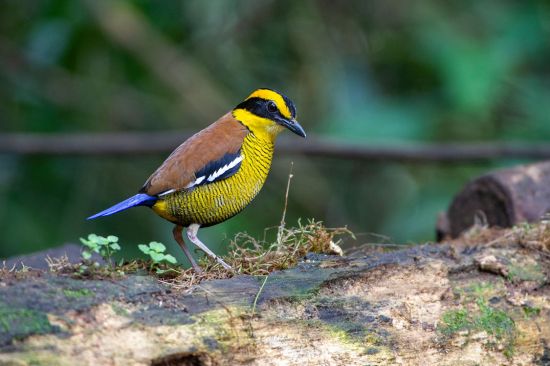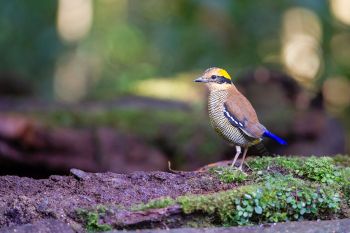- Hydrornis schwaneri
Identification
20 - 23cm. An unmistakable pitta.
- Top and side of head black with prominent, broad bright yellow supercilium
- Plain chestnut-brown upperparts
- Blackish-brown wings with white spots creating a wingbar
- Deep blue rump and tail
- White chin and throat, becoming yellow on lower throat
- Narrow dark blue band on upper breast
- Yellow rest of underparts with blackish barring and large blue belly patch
- Black bill
Females are duller and the blue breastband is very narrow. No blue on underparts.
Juveniles are speckled brown and their bill has an orange base and an orange tip.
Distribution
Endemic to Borneo.
Fairly common where suitable habitat remains. Population declining due to habitat loss and cagebird trading.
Taxonomy
This is a monotypic species.
It was formerly included in Banded Pitta together with Javan Banded Pitta and Malayan Banded Pitta.
Formerly placed in genus Pitta.
Habitat
Moist lowland forests and montanes. Rarely in older secondary forest. Occurs from lowlands up to 1500m.
Behaviour
Feeds mainly on insects, snails and earthworms. Takes also berries.
Forages on the ground.
Breeding season differs through range. The globular nest has a side entrance and is build with broad leaves, sleletonized bamboo leaves, small sticks and grass. It's placed low in a bush, a sapling or a rattan palm. Lays 2 - 5 eggs, mostly 3 or 4.
A resident species.
References
- Clements, J. F., T. S. Schulenberg, M. J. Iliff, T. A. Fredericks, J. A. Gerbracht, D. Lepage, S. M. Billerman, B. L. Sullivan, and C. L. Wood. 2022. The eBird/Clements checklist of Birds of the World: v2022. Downloaded from https://www.birds.cornell.edu/clementschecklist/download/
- Dickinson, EC, ed. 2003. The Howard and Moore Complete Checklist of the Birds of the World. 3rd ed., with updates to October 2008 (Corrigenda 8). Princeton: Princeton Univ. Press. ISBN 978-0691117010
- Gill, F and D Donsker (Eds). 2010. IOC World Bird Names (version 2.7). Available at http://www.worldbirdnames.org/.
- Birdforum thread discussing taxonomy of this species
- Del Hoyo, J, A Elliot, and D Christie, eds. 2003. Handbook of the Birds of the World. Volume 8: Broadbills to Tapaculos. Barcelona: Lynx Edicions. ISBN 978-8487334504
Recommended Citation
- BirdForum Opus contributors. (2024) Bornean Banded Pitta. In: BirdForum, the forum for wild birds and birding. Retrieved 28 April 2024 from https://www.birdforum.net/opus/Bornean_Banded_Pitta
External Links
GSearch checked for 2020 platform.





